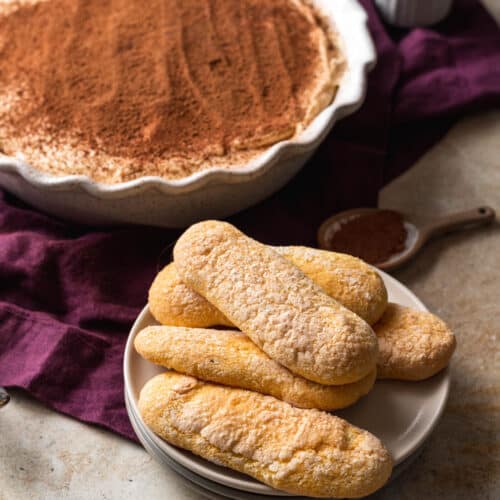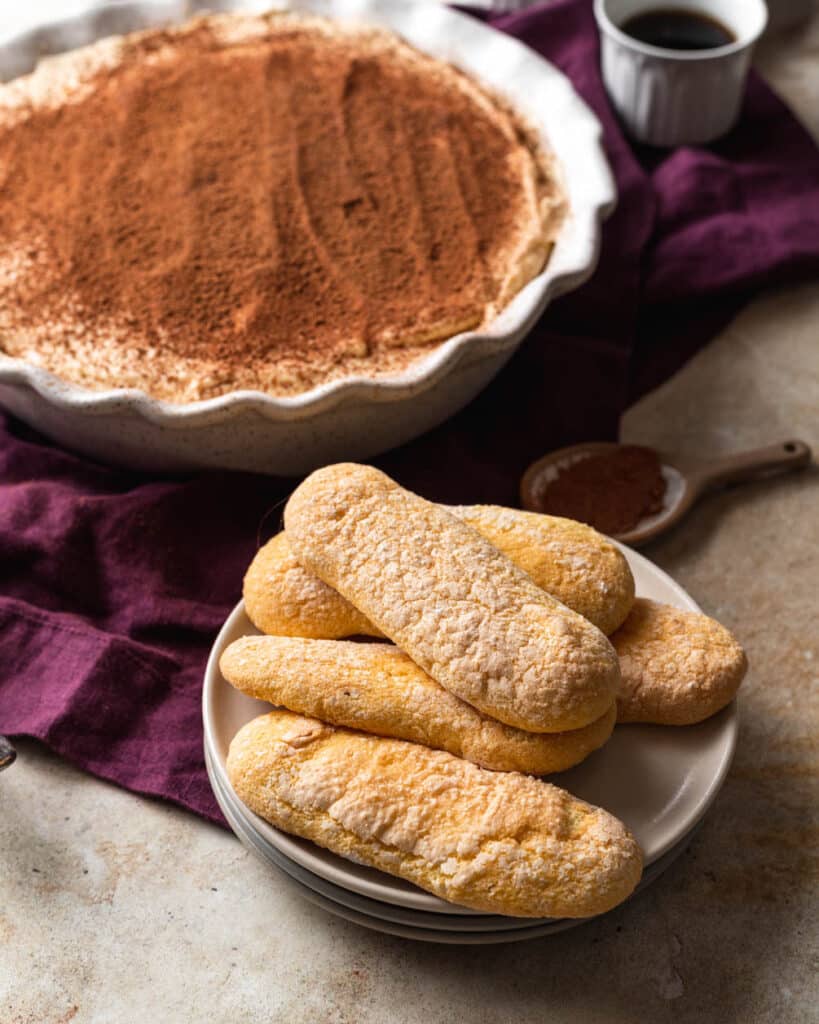Ladyfingers, or biscuit cuillère, is a light sponge cake leavened just with whipped up eggs. It is very light and airy, and is often used in a variety of desserts.
This page may contain affiliate links. This means I may get a small commission if you purchase through these links, at no additional cost to you.
What are signs of a well-made ladyfinger?
A well-made ladyfinger should be light and fluffy. It will have a soft and supple exterior, with a light, spongey center. They should not be dry, crisp, hard, or flat.
What desserts can you use ladyfingers in?
The most popular dessert to use ladyfingers in is tiramisu, such as my classic tiramisu recipe.
Ladyfinger sponge is also often paired with cream or mousse in Charlotte Cakes, a delicious French cake.
Because it’s very light and flexible, I also like to use it in roll cakes, such as this Hojicha swiss roll.
Ingredients for homemade ladyfingers (biscuit cuillère)
Ladyfinger sponge is made with just a few simple ingredients:
- Eggs – Both the yolks and the whites will be used for this recipe, and the ladyfingers will be leavened by fluffing up the egg whites
- Granulated sugar – Granulated sugar is whipped with the eggs to stabilize and add sweetness
- All purpose flour – All purpose flour is gently folded into the whipped eggs to add substance to the batter
- Powdered sugar – An optional dusting of powdered sugar before baking adds a beautiful, crackly crust on the outside of the sponge
Tools for making ladyfingers
- Hand mixer or stand mixer with whisk attachment – needed to whip up the egg whites to stiff peaks
- Large bowl – it needs to be able to hold all of the batter, and it’s better to err on the side of too large rather than too small
- Silicone Spatula – French sponges are all about gently folding with a spatula, so as to not deflate the whipped eggs. A good flexible silicone spatula is key. I have this heat-proof spatula.
- Piping bag – The batter needs to be piped into a collar and rounds before baking. If you don’t have piping bags, they are a great investment if you want to do more advanced baking. I use these bags from Ateco
- Round piping tip – a 10mm round piping tip will help you pipe even and aesthetically pleasing lines
- Baking tray – The sponges need to go into the oven on something. If you only have one tray, you will need to cool down your tray after each batch before piping a new batch of ladyfingers.
- Parchment paper – Keeps the sponge from sticking to the baking tray
How to make ladyfingers
In pastry school, I learned to make ladyfingers by whipping up the egg whites and yolks separately. However, I find this to be a bit annoying for a few reasons:
- You need 2 large bowls
- You either need 2 mixers, or you have to whip the whites and yolks one at a time
Instead, in this recipe I will be using a technique I learned from Christophe Felder, where we only whip up the egg whites, then beat the yolks directly into the whites.
Mise en place
- Separate your eggs. Make sure there are no yolks in the whites, because you’re going to make a meringue, and the whites won’t whip up properly if there’s any traces of yolk.
- Scale out all your flour and granulated sugar and have them ready to go
- Line your baking trays with parchment paper
- Add the piping tip to the piping bag so it’s ready to go
Make the meringue and add the yolks
- Place the whites in your mixing bowl, and mix on medium-high speed with the whisk attachment until soft peaks form. The whites will form small, dense bubbles, and the whisk will leave trails behind as it spins.
- While the mixer is going, add the sugar a little at a time. You will notice the bubbles start to smoothen and tighten up, taking on a glossier sheen
- Mix on high speed until stiff peaks form. At stiff peaks, the egg whites will look glossy and thick, and will hold their shape without sagging or drooping.
- With the mixer still running on high speed, add the egg yolks one at a time until they are fully incorporated. The result should be thick and fluffy, with a pale yellow color.
Fold in the flour
- Fold the flour into the eggs in 3 – 4 batches. Make sure to sift the flour
- Fold until the flour is incorporated, without large dry pockets. When folding, be careful not to squash out the air. I move my spatula in a J motion, going down and then turning up and over. It helps to rotate the bowl as you fold.
Pipe the batter
- Place the batter in the prepped piping bag
- Pipe into whatever shape you desire. Traditional ladyfingers are individual biscuits. You can also make one continuous sponge.
- Dust with powdered sugar
Bake
- Bake at 400F for 9 – 10 min until the outside is lightly browned. When you press the sponge with your finger, it should spring back
Tips for making perfect ladyfingers
The number one most important thing to remember is: don’t squash the air out from the batter.
There are no chemical leaveners in this sponge. It will only be light and fluffy if your eggs are light and fluffy.
If you don’t whip up the eggs enough, or you squash the air out, then the batter will be runny and your sponge will be flat.
Here are my tips:
- If you’re not already doing this, please use a food scale. It will help so much with accuracy.
- Don’t add the sugar to the egg whites too early, as it can weigh down the eggs and prevent the eggs from whipping up fully
- Don’t add the sugar to the egg whites too late, as it can be grainy and prevent the eggs from whipping up fully
- Make sure you’ve whipped your egg whites to stiff peaks
- When folding, be gentle and use a lifting motion. Make sure you cut through the center of the bowl, not just the edges. Often flour pockets will be hiding in the middle.
- When folding, rotate the bowl as you fold
- Bake at a high temperature for a short period of time. This keeps the ladyfingers from drying out in the middle.
How should you pipe the ladyfinger sponge batter?
The most popular shape for ladyfinger sponge is as individual biscuits, that look like little fingers.
However, don’t limit yourself to just this shape. For example, if you’re making a layered cake, you can pour the batter onto a sheet tray and smooth out with a spatula. This will give you an even, unbroken layer of sponge rather than individual ladyfingers. Or, if you’re making a round cake, you can pipe the batter into disks.
For visuals, please watch this video:
Want to save this recipe?

Ladyfingers (Biscuit Cuillère
Equipment
- Hand mixer or stand mixer (with whisk attachment)
- large bowl
- spatula
- Piping bag
- Round piping tip (10mm)
- Baking trays
- Parchment paper
Ingredients
- 180g (1 1 /2 cups) All purpose flour
- 6 eggs, separated
- 180g (3/4 cup + 2 tbsp) granulated sugar
- 50g (1/4 cup) powdered sugar, for dusting
Instructions
Prep work (mise en place)
- Preheat the oven to 400F and line your baking trays with parchment paper
- Separate your eggs and measure out your flour and granulated sugar
- Prepare your piping tip or spatula
Make the meringue and add the yolks
- Place the whites in your mixing bowl, and mix on medium-high speed with the whisk attachment until soft peaks form. The whites will form small, dense bubbles, and the whisk will leave trails behind as it spins.
- While the mixer is going, add the sugar a little at a time. You will notice the bubbles start to smoothen and tighten up, taking on a glossier sheen
- Mix on high speed until stiff peaks form. At stiff peaks, the egg whites will look glossy and thick, and will hold their shape without sagging or drooping.
- With the mixer still running on high speed, add the egg yolks one at a time until they are fully incorporated. The result should be thick and fluffy, with a pale yellow color.
Fold in the flour
- Fold the flour into the eggs in 3 – 4 batches. Make sure to sift the flour with each addition
- Fold until the flour is incorporated, without large dry pockets. When folding, be careful not to squash out the air. I move my spatula in a J motion, going down and then turning up and over. It helps to rotate the bowl as you fold.
Pipe or spread the batter
- If you're making traditional ladyfingers – place the batter in a piping bag with a round tip, and pipe into 4 inch vertical lines. Leave ~1 inch between each biscuit as they will spread in the oven
- If you're making an unbroken sheet or disk – spread the batter with a spatula or pipe into your desired shape
- Dust with powdered sugar to create a crackly effect after baking
Bake
- Bake at 400F for 9 – 10 min until the outside is lightly browned. When you press the sponge with your finger, it should spring back

